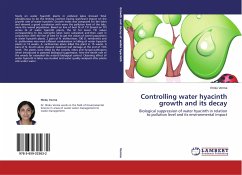
Controlling water hyacinth growth and its decay
Biological suppression of water hyacinth in relation to pollution level and its environmental impact
Versandkostenfrei!
Versandfertig in 6-10 Tagen
33,99 €
inkl. MwSt.

PAYBACK Punkte
17 °P sammeln!
Study on water hyacinth plants in polluted lakes showed Total phosphorous to be the limiting nutrient having significant impact on the growth rate of water hyacinth. Growth Index was computed for the lakes and showed a good correlation with more the pollution level of the lake, more the weevil population. Based on line of best fit of TSI (based on TP) versus GI of water hyacinth plants, the GI for lower TSI values corresponding to less eutrophic lakes were calculated and then used in conjunction with the line of best fit to get the values of weevil population in water hyacinth plants. 2 pairs ...
Study on water hyacinth plants in polluted lakes showed Total phosphorous to be the limiting nutrient having significant impact on the growth rate of water hyacinth. Growth Index was computed for the lakes and showed a good correlation with more the pollution level of the lake, more the weevil population. Based on line of best fit of TSI (based on TP) versus GI of water hyacinth plants, the GI for lower TSI values corresponding to less eutrophic lakes were calculated and then used in conjunction with the line of best fit to get the values of weevil population in water hyacinth plants. 2 pairs of N. eichhorniae, 100 O. terebrantis and A. eichhorniae was most efficient combination in killing of water hyacinth plants in 13 weeks. A. eichhorniae alone killed the plant in 15 weeks. 6 pairs of N. bruchi alone showed maximum leaf damage at the end of 15th week. The plants were killed by the weevils, mites and fungal pathogens when introduced in planned biological suppression, here the death rate of the weeds far exceeded the natural biological control. Cleansing effect of water hyacinth in lakes was studied and water quality analyzed after plants sink under water.


